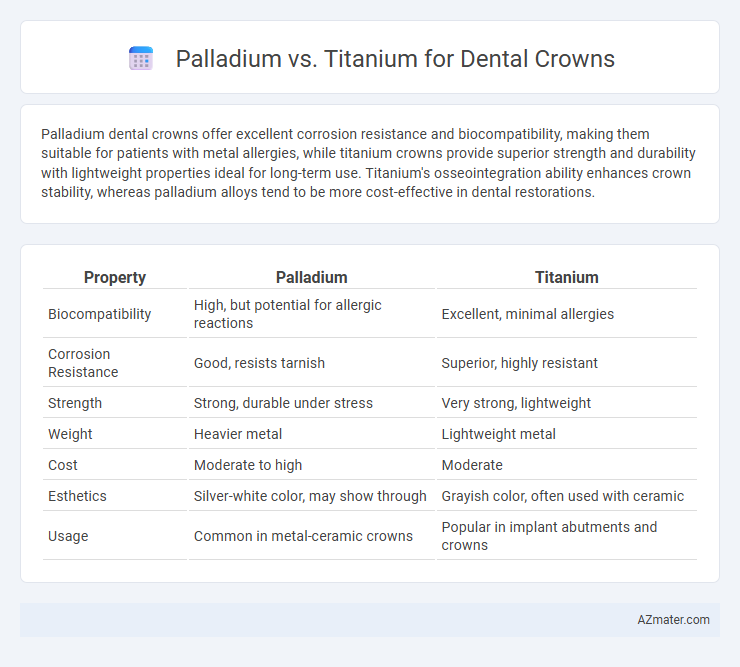Palladium dental crowns offer excellent corrosion resistance and biocompatibility, making them suitable for patients with metal allergies, while titanium crowns provide superior strength and durability with lightweight properties ideal for long-term use. Titanium's osseointegration ability enhances crown stability, whereas palladium alloys tend to be more cost-effective in dental restorations.
Table of Comparison
| Property | Palladium | Titanium |
|---|---|---|
| Biocompatibility | High, but potential for allergic reactions | Excellent, minimal allergies |
| Corrosion Resistance | Good, resists tarnish | Superior, highly resistant |
| Strength | Strong, durable under stress | Very strong, lightweight |
| Weight | Heavier metal | Lightweight metal |
| Cost | Moderate to high | Moderate |
| Esthetics | Silver-white color, may show through | Grayish color, often used with ceramic |
| Usage | Common in metal-ceramic crowns | Popular in implant abutments and crowns |
Introduction to Dental Crown Materials
Dental crowns are primarily crafted from materials like palladium and titanium, each offering distinct benefits for dental restorations. Palladium, a precious metal, is valued for its corrosion resistance and biocompatibility, making it a durable option for crowns. Titanium, known for its exceptional strength, lightweight nature, and excellent compatibility with bodily tissues, is increasingly preferred in dental implants and crowns to ensure long-lasting performance.
Overview of Palladium in Dental Crowns
Palladium is a precious metal commonly used in dental crowns due to its durability, corrosion resistance, and biocompatibility. It offers excellent strength and longevity, making it suitable for both posterior and anterior restorations, especially when alloyed with other metals like gold and silver. Palladium's hypoallergenic properties reduce the risk of allergic reactions in sensitive patients, contributing to its popularity in prosthetic dentistry.
Overview of Titanium in Dental Crowns
Titanium dental crowns offer exceptional biocompatibility, making them highly resistant to corrosion and ideal for patients with metal allergies. Their lightweight nature and superior strength provide durability and comfort, while their natural grayish color can be less aesthetically pleasing compared to porcelain-fused or ceramic crowns. Titanium's integration with bone tissue promotes long-term stability, making it a preferred material in dental implants and restorative dentistry.
Biocompatibility: Palladium vs Titanium
Titanium exhibits superior biocompatibility compared to palladium due to its exceptional corrosion resistance and ability to osseointegrate with surrounding tissues, reducing the risk of allergic reactions and inflammation. Palladium, while used in dental alloys, carries a higher potential for metal hypersensitivity and less predictable tissue response. Titanium's compatibility with bone and soft tissues makes it the preferred choice for dental crown frameworks in patients with metal sensitivities.
Strength and Durability Comparison
Palladium dental crowns offer excellent strength with high resistance to corrosion, making them durable in oral environments but often come at a higher cost due to precious metal content. Titanium crowns provide superior biocompatibility and exceptional strength-to-weight ratio, ensuring long-lasting durability while being lightweight and less likely to cause allergic reactions. Both metals exhibit excellent longevity, but titanium's enhanced strength and corrosion resistance make it increasingly preferred for long-term dental restorations.
Aesthetics and Appearance
Titanium dental crowns offer a metallic gray color that may show through translucent dental materials, potentially impacting the natural appearance, whereas palladium crowns provide better color matching with natural teeth due to their less reflective, silvery-white hue. Palladium's higher corrosion resistance preserves crown luster and minimizes discoloration over time, enhancing long-term aesthetics. The biocompatibility and distinct coloration of palladium often result in crowns that blend more seamlessly with surrounding enamel compared to titanium alternatives.
Potential Allergies and Sensitivities
Palladium dental crowns may trigger allergic reactions in sensitive individuals, with symptoms ranging from localized irritation to more severe mucosal inflammation due to its metal composition. Titanium, known for its biocompatibility, exhibits a significantly lower risk of hypersensitivity and is often preferred for patients with metal allergies or sensitivities. Dental professionals commonly recommend titanium crowns for patients with a history of metal allergies to minimize the potential for adverse immune responses.
Cost Differences: Palladium vs Titanium
Palladium dental crowns tend to be more expensive than titanium crowns due to the higher market price of palladium as a precious metal and its specialized alloy composition. Titanium crowns offer a cost-effective option while maintaining strength and biocompatibility, contributing to their growing popularity in dental restorations. The overall cost difference can vary based on factors such as location, dental laboratory fees, and the specific alloy used, but titanium generally remains the more budget-friendly choice for dental crowns.
Lifespan and Long-Term Performance
Palladium dental crowns typically offer excellent corrosion resistance and durability, with an average lifespan of 10 to 15 years due to their strong biocompatibility and wear resistance. Titanium crowns provide superior strength and biocompatibility, often lasting 15 to 20 years or more, especially in patients with metal sensitivities. Long-term performance of titanium is enhanced by its lightweight nature and resistance to fracture, making it a preferred option for longevity in dental restorations.
Choosing the Right Material for Your Dental Crown
Palladium dental crowns offer excellent corrosion resistance and durability, making them a popular choice for long-lasting restorations, especially for patients with metal sensitivities. Titanium crowns provide exceptional biocompatibility and strength with a lightweight structure, ideal for patients seeking metal-free options. Evaluating factors like allergies, budget, aesthetic preferences, and the crown's location in the mouth ensures selecting the right material to balance functionality and oral health.

Infographic: Palladium vs Titanium for Dental Crown
 azmater.com
azmater.com